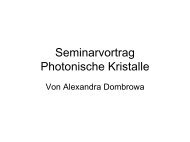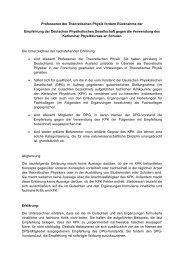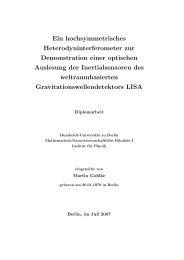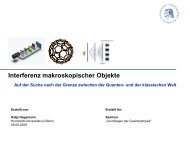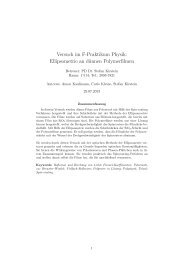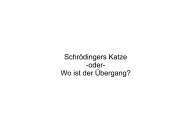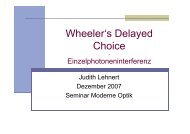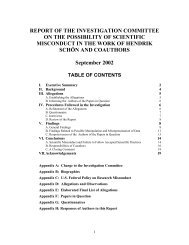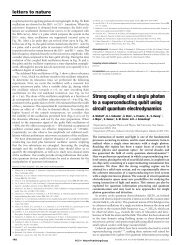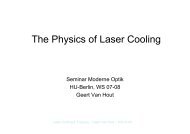Biomolecular Recognition Based on Single Gold Nanoparticle Light ...
Biomolecular Recognition Based on Single Gold Nanoparticle Light ...
Biomolecular Recognition Based on Single Gold Nanoparticle Light ...
You also want an ePaper? Increase the reach of your titles
YUMPU automatically turns print PDFs into web optimized ePapers that Google loves.
<str<strong>on</strong>g>Biomolecular</str<strong>on</strong>g> <str<strong>on</strong>g>Recogniti<strong>on</strong></str<strong>on</strong>g> <str<strong>on</strong>g>Based</str<strong>on</strong>g> <strong>on</strong><br />
<strong>Single</strong> <strong>Gold</strong> <strong>Nanoparticle</strong> <strong>Light</strong><br />
Scattering<br />
G. Raschke,* S. Kowarik, T. Franzl, C. So1nnichsen, † T. A. Klar, and J. Feldmann<br />
Phot<strong>on</strong>ics and Optoelectr<strong>on</strong>ics Group, Department of Physics and CeNS,<br />
Ludwig-Maximilians-UniVersität, Amalienstr. 54, D-80799 Munich, Germany<br />
A. Nichtl and K. Ku1rzinger<br />
Roche Diagnostics GmbH, N<strong>on</strong>nenwald 2, D-82372 Penzberg, Germany<br />
Received April 14, 2003<br />
ABSTRACT<br />
A method for biomolecular recogniti<strong>on</strong> is reported using light scattering of a single gold nanoparticle functi<strong>on</strong>alized with biotin. Additi<strong>on</strong> of<br />
streptavidin and subsequent specific binding events alter the dielectric envir<strong>on</strong>ment of the nanoparticle, resulting in a spectral shift of the<br />
particle plasm<strong>on</strong> res<strong>on</strong>ance. As we use single nanoparticles showing a homogeneous scattering spectrum, spectral shifts as small as 2 meV<br />
can be detected.<br />
<str<strong>on</strong>g>Biomolecular</str<strong>on</strong>g> recogniti<strong>on</strong> has become an indispensable tool<br />
in clinical diagnostics as well as in pharmacology. Practically<br />
all relevant recogniti<strong>on</strong> schemes rely <strong>on</strong> specific biomolecular<br />
recogniti<strong>on</strong> reacti<strong>on</strong>s. Several techniques are in use today<br />
to m<strong>on</strong>itor molecular binding events, including radioactive<br />
labeling, as well as chemical and optical detecti<strong>on</strong>. Even<br />
though each of these techniques has its own strengths and<br />
limitati<strong>on</strong>s, for many applicati<strong>on</strong>s optical assays are the<br />
method of choice.<br />
In this letter we present a method for specific biomolecular<br />
detecti<strong>on</strong> based <strong>on</strong> light scattering spectroscopy of single<br />
gold nanoparticles. Sub-wavelength sized noble metal nanoparticles<br />
show a pr<strong>on</strong>ounced res<strong>on</strong>ance in their scattering<br />
spectrum for visible light. This nanoparticle plasm<strong>on</strong> (NPP)<br />
res<strong>on</strong>ance can be tuned over a wide spectral range by<br />
changing intrinsic parameters such as the nanoparticle’s<br />
material, its size, or its geometrical shape. 1,2 Even more<br />
importantly, extrinsic parameters such as the dielectric<br />
properties of the particle’s immediate envir<strong>on</strong>ment (nanoenvir<strong>on</strong>ment)<br />
or charge distributi<strong>on</strong>s decisively influence the<br />
NPP res<strong>on</strong>ance positi<strong>on</strong>. 1,3 For a 40 nm sized nanoparticle,<br />
the res<strong>on</strong>ance is sensitive <strong>on</strong>ly to the refractive index 10 to<br />
20 nm above the nanoparticle’s surface. Only a change of<br />
refractive index inside this nanoenvir<strong>on</strong>ment should lead to<br />
a significant shift of the NPP res<strong>on</strong>ance spectrum.<br />
* Corresp<strong>on</strong>ding author. E-mail: gunnar.raschke@physik.uni-muenchen.de<br />
† Present address: Lawrence Berkeley Nati<strong>on</strong>al Laboratory, Hildebrand<br />
Hall Box 101, Berkeley, CA 94720.<br />
10.1021/nl034223+ CCC: $25.00 © 2003 American Chemical Society<br />
Published <strong>on</strong> Web 05/30/2003<br />
NANO<br />
LETTERS<br />
2003<br />
Vol. 3, No. 7<br />
935-938<br />
<str<strong>on</strong>g>Biomolecular</str<strong>on</strong>g> binding events close to the surface of a noble<br />
metal nanoparticle may increase the refractive index of the<br />
nanoparticle’s immediate envir<strong>on</strong>ment and subsequently<br />
cause a red shift of the homogeneous NPP res<strong>on</strong>ance.<br />
Accordingly, <strong>on</strong>e of the binding partners has to be attached<br />
to the surface of the gold nanoparticle, i.e., the nanoparticle<br />
has to be functi<strong>on</strong>alized. Our assay proposal is based <strong>on</strong><br />
changing and measuring the spectrum of an indiVidual<br />
nanoparticle. This is c<strong>on</strong>ceptually different from other assays<br />
utilizing noble metal nanoparticles, as they either rely <strong>on</strong><br />
determining the amount of bound gold nanoparticles, 4-7 use<br />
coupled particle plasm<strong>on</strong> oscillati<strong>on</strong>s, 8-11 or rely <strong>on</strong> large<br />
ensembles of nanoparticles. 12,13 Recent studies use twodimensi<strong>on</strong>al<br />
arrays of noble metal nanoparticles to detect<br />
molecules of high molecular weight, 14 or the measurements<br />
are carried out in nitrogen atmosphere. 15 For those cases,<br />
the spectral changes are sufficiently large to be detected in<br />
ensemble measurements. A single nanoparticle assay, however,<br />
should be sensitive enough to detect spectral shifts of<br />
<strong>on</strong>ly a few meV, which would be caused, e.g., by lower<br />
molecular weight molecules under physiological c<strong>on</strong>diti<strong>on</strong>s.<br />
<strong>Single</strong> metal nanoparticle spectroscopy has been successfully<br />
dem<strong>on</strong>strated by using near-field scanning optical, 16 total<br />
internal reflecti<strong>on</strong>, 17 and dark-field microscopy. 2,4 Important<br />
further advantages of single-nanoparticle sensors are that in<br />
principle <strong>on</strong>ly a small absolute number of analyte molecules<br />
are used and that they feature the possibility of miniaturizati<strong>on</strong><br />
and hence massive parallelizati<strong>on</strong>.
Figure 1. Principle and schematic representati<strong>on</strong> of a biosensor<br />
based <strong>on</strong> light scattering from a single gold nanoparticle. (a) <strong>Single</strong><br />
gold nanoparticles are functi<strong>on</strong>alized with biotinylated BSA which<br />
subsequently binds streptavidin. (b) Mie theory calculati<strong>on</strong>s for the<br />
three different envir<strong>on</strong>ments shown in (a). (c) Left: true color<br />
photograph of a sample of functi<strong>on</strong>alized gold nanoparticles in darkfield<br />
illuminati<strong>on</strong>. Right: experimental setup facilitating dark-field<br />
microscopy of single gold nanoparticles immersed in liquids.<br />
Figure 1a shows c<strong>on</strong>ceptually how protein binding events<br />
cause a change in refractive index of the nanoenvir<strong>on</strong>ment<br />
of a gold nanoparticle. In our model the refractive index<br />
gradually changes from that of a buffer soluti<strong>on</strong> (n ) 1.33)<br />
in the case of bare nanoparticles, over a3nmthick shell of<br />
higher refractive index after functi<strong>on</strong>alizing the nanoparticles<br />
with acceptor molecules, to an increased 5 nm shell of high<br />
refractive index up<strong>on</strong> analyte binding (Figure 1a). Using Mie<br />
theory 18 we have calculated the scattering spectra for these<br />
three cases assuming a refractive index of n ) 1.5 for<br />
proteins (Figure 1b). This calculati<strong>on</strong> predicts that the NPP<br />
res<strong>on</strong>ance of an uncoated nanoparticle (Figure 1b, black<br />
curve) shifts 16 meV to the red as a result of functi<strong>on</strong>alizati<strong>on</strong><br />
(Figure 1b, red curve) and by another 7.5 meV up<strong>on</strong><br />
formati<strong>on</strong> of a complete shell of analyte molecules (Figure<br />
1b, green curve).<br />
In Figure 1c the scattered light from single individual<br />
functi<strong>on</strong>alized gold nanoparticles of 40 nm diameter, electrostatically<br />
attached <strong>on</strong> a cover slip, can be seen with the<br />
naked eye in a dark-field microscope setup. White light from<br />
Figure 2. Spectroscopic detecti<strong>on</strong> of streptavidin binding to a single<br />
gold nanoparticle functi<strong>on</strong>alized with biotin-BSA. (a, b) Comparis<strong>on</strong><br />
of experimental NPP res<strong>on</strong>ance spectra in buffer before (solid line)<br />
and 30 min after adding streptavidin (dashed line). (c) Differential<br />
spectrum of the two scattering spectra shown in (b).<br />
a 100 W halogen lamp is focused under large angles <strong>on</strong>to<br />
the sample using a dark-field c<strong>on</strong>denser with high numerical<br />
aperture (NA ) 1.2-1.4). As depicted in Figure 1c, the<br />
scattered light of a single nanoparticle in focus can be<br />
collected by a water immersi<strong>on</strong> objective lens (100×, NA<br />
) 1.0), spectrally resolved in a grating spectrometer, and<br />
detected with a nitrogen-cooled and back-illuminated CCD<br />
camera. In the following we show that the NPP scattering<br />
res<strong>on</strong>ance red shifts up<strong>on</strong> specific analyte binding.<br />
First, the nanoparticles are functi<strong>on</strong>alized with biotinylated<br />
bovine serum albumin (biotin-BSA) molecules (MW: 67 000<br />
D). As analyte we use streptavidin (MW: 52 000 D), a<br />
tetrameric protein which can bind up to four biotin molecules.<br />
Biotin-BSA coated gold nanoparticles are immobilized <strong>on</strong>to<br />
the surface of a silanized glass substrate and covered by 10<br />
mM Tris [NH2C(CH2OH)3]/BSA buffer soluti<strong>on</strong> (pH 8.0, 0.5<br />
mg/mL BSA). Silanizati<strong>on</strong> together with BSA in the buffer<br />
soluti<strong>on</strong> is intended to prevent n<strong>on</strong>specific streptavidin<br />
binding <strong>on</strong> the glass substrate and the objective lens. For an<br />
individual functi<strong>on</strong>alized nanoparticle we find a scattering<br />
spectrum at a res<strong>on</strong>ance positi<strong>on</strong> of 2.282 eV (Figure 2a,b,<br />
solid curve). To start the experiment, 10 µL potassium<br />
phosphate buffer (pH 6.5, 20 mM) c<strong>on</strong>taining 6 × 10 -5<br />
mol/L streptavidin is added to a final streptavidin c<strong>on</strong>centrati<strong>on</strong><br />
of 2 × 10 -6 mol/L. The assay is then incubated for 30<br />
min. This results in a 5 meV spectral shift of the NPP<br />
res<strong>on</strong>ance curve (Figure 2a,b, dashed curve) which is also<br />
clearly seen in the differential spectrum (Figure 2c). The<br />
shape of this differential scattering spectrum indicates that<br />
the additi<strong>on</strong> of streptavidin induces a pure shift of the NPP<br />
res<strong>on</strong>ance. The experimentally determined shift of 5 meV<br />
936 Nano Lett., Vol. 3, No. 7, 2003
Figure 3. Res<strong>on</strong>ance shift versus incubati<strong>on</strong> time for different<br />
streptavidin c<strong>on</strong>centrati<strong>on</strong>s and c<strong>on</strong>trol experiments. Up<strong>on</strong> additi<strong>on</strong><br />
of streptavidin at time t ) 0 the NPP res<strong>on</strong>ance starts to red shift<br />
(green triangles and orange circles), while additi<strong>on</strong> of potassium<br />
phosphate storage buffer leaves the res<strong>on</strong>ance positi<strong>on</strong> unchanged<br />
(red squares). The streptavidin c<strong>on</strong>centrati<strong>on</strong> is 1 × 10 -6 mol/L<br />
and 2 × 10 -6 mol/L for triangles and circles, respectively. Additi<strong>on</strong><br />
of streptavidin to a final c<strong>on</strong>centrati<strong>on</strong> of 1 × 10 -6 mol/L to a<br />
nanoparticle coated with n<strong>on</strong>biotinylated proteins shows no evidence<br />
for unspecific binding events (blue asterisks).<br />
agrees well with the theoretically expected value of 7.5 meV<br />
for free nanoparticles in buffer soluti<strong>on</strong>. The difference can<br />
be easily explained by the fact that in the experiment the<br />
nanoparticles are not free, but attached to a substrate.<br />
Accordingly, <strong>on</strong>e-third of the functi<strong>on</strong>alized nanoparticle<br />
surface is not available for the analyte molecules.<br />
To ensure that the observed red shift is not caused by the<br />
added potassium phosphate storage buffer of the streptavidin<br />
or due to unspecific binding, we perform supplementary<br />
c<strong>on</strong>trol experiments. First, we m<strong>on</strong>itor the res<strong>on</strong>ance positi<strong>on</strong><br />
of an individual nanoparticle coated with biotin-BSA in Tris/<br />
BSA buffer for 15 min (Figure 3, red squares). At t ) 0<br />
min, 10 µL of potassium phosphate buffer (equal to the<br />
streptavidin storage buffer) is added to the soluti<strong>on</strong>. Subsequent<br />
m<strong>on</strong>itoring of the res<strong>on</strong>ance positi<strong>on</strong> for additi<strong>on</strong>al<br />
45 min does not show any shift, and hence buffer-induced<br />
changes of the nanoenvir<strong>on</strong>ment do not occur. In a sec<strong>on</strong>d<br />
c<strong>on</strong>trol experiment we use gold nanoparticles coated with<br />
n<strong>on</strong>biotinylated proteins. This time, at t ) 0 min streptavidin<br />
is added to the Tris/BSA buffer up to a final c<strong>on</strong>centrati<strong>on</strong><br />
of 1 × 10 -6 mol/L. As shown by the blue asterisks in Figure<br />
3, no spectral shift occurs. We thus c<strong>on</strong>clude that the<br />
observed red shift is a direct c<strong>on</strong>sequence of streptavidin<br />
binding.<br />
Now we turn to the kinetics of the specific binding<br />
processes. At time t ) 0 min, 3.12 mg/mL streptavidin<br />
(corresp<strong>on</strong>ding to a molar c<strong>on</strong>centrati<strong>on</strong> of 6 × 10 -5 mol/<br />
L) is added to a Tris/BSA buffer soluti<strong>on</strong> (10 mM, pH 8.0,<br />
0.5 mg/mL), resulting in a final streptavidin c<strong>on</strong>centrati<strong>on</strong><br />
of 100 µg/mL (2 × 10 -6 mol/L). One minute after streptavidin<br />
additi<strong>on</strong>, the NPP res<strong>on</strong>ance positi<strong>on</strong> exhibits a<br />
significant red shift (Figure 3, orange circles). It saturates<br />
with increasing incubati<strong>on</strong> time and reaches a c<strong>on</strong>stant total<br />
displacement of 5 meV after approximately 15 min. Data<br />
points plotted as green triangles in Figure 3 corresp<strong>on</strong>d to a<br />
lower c<strong>on</strong>centrati<strong>on</strong>, where streptavidin is added at t ) 0<br />
min to a final c<strong>on</strong>centrati<strong>on</strong> of 50 µg/mL (1 × 10 -6 mol/L).<br />
Compared to the higher c<strong>on</strong>centrati<strong>on</strong>, the red shift evolves<br />
<strong>on</strong> a slower time scale and the total NPP shift is reduced.<br />
In the following we show that the observed time behavior<br />
is governed by the kinetics of the binding reacti<strong>on</strong> and is<br />
not limited by diffusi<strong>on</strong>. The rate ∆N/∆t of streptavidin<br />
molecules impinging <strong>on</strong>to a free nanoparticle due to diffusi<strong>on</strong><br />
is given by 19 ∆N/∆t ) 4π DrC, where D ) 7.4 × 10 -7 cm 2 /s<br />
is the diffusi<strong>on</strong> c<strong>on</strong>stant of streptavidin, 20 r ) 23 nm is the<br />
radius of a functi<strong>on</strong>alized nanoparticle, and C ) 1 × 10 -6<br />
mol/L is the molar c<strong>on</strong>centrati<strong>on</strong> of free streptavidin<br />
molecules. For diffusi<strong>on</strong>-limited kinetics this rate would lead<br />
to a completely filled streptavidin shell around the functi<strong>on</strong>alized<br />
nanoparticle in less than <strong>on</strong>e sec<strong>on</strong>d. C<strong>on</strong>sequently,<br />
the observed time evoluti<strong>on</strong> of the NPP res<strong>on</strong>ance shift is<br />
not determined by diffusi<strong>on</strong> but by the kinetics of the binding<br />
reacti<strong>on</strong>. For our data set we apply a first-order model for<br />
binding analyte molecules to acceptor sites. 21 The deduced<br />
affinity c<strong>on</strong>stant of Ka ) 10 6 L/mol is much lower than<br />
expected for free biotin-streptavidin binding. We attribute<br />
this low value to the fact that the biotin molecules are located<br />
within a disordered protein network of BSA molecules. This<br />
leads to limited accessibility of biotin molecules and thus<br />
lower associati<strong>on</strong> rates. In additi<strong>on</strong>, the BSA matrix may<br />
cause enhanced dissociati<strong>on</strong> of bound biotin- streptavidin<br />
complexes. Low associati<strong>on</strong> rates and enhanced dissociati<strong>on</strong><br />
rates due to surface effects lead to drastically reduced affinity<br />
c<strong>on</strong>stants. 22<br />
In c<strong>on</strong>clusi<strong>on</strong>, this study dem<strong>on</strong>strates a real-time biotinstreptavidin<br />
affinity biosensor using light scattering spectroscopy<br />
of single gold nanoparticles. We expect further<br />
improvements of the limit of detecti<strong>on</strong> by sharpening of the<br />
res<strong>on</strong>ance peak as it can, in principle, be achieved by the<br />
use of nanorods instead of nanospheres. 2 C<strong>on</strong>sidering the<br />
tiny dimensi<strong>on</strong>s of a single nanoparticle, this type of assay<br />
provides the potential to miniaturize immunoassays down<br />
to the micr<strong>on</strong> scale and parallelize them, e.g., in array formats<br />
for multiplex testing.<br />
Acknowledgment. We thank M. Seitz and C. Effenhauser<br />
for fruitful discussi<strong>on</strong>s as well as A. Helfrich, D. Spahn, and<br />
W. Stadler for excellent technical assistance. Financial<br />
support by the Bayerische Forschungsstiftung through the<br />
funding program For Nano is gratefully acknowledged.<br />
References<br />
(1) Kreibig, U.; Vollmer, M. Optical Properties of Metal Clusters;<br />
Springer: Berlin, 1995.<br />
(2) Sönnichsen, C.; Franzl, T.; Wilk, T.; v<strong>on</strong> Plessen, G.; Feldmann, J.;<br />
Wils<strong>on</strong>, O.; Mulvaney, P. Phys. ReV. Lett. 2002, 88, 077402.<br />
(3) Mulvaney, P. Langmuir 1996, 12, 788.<br />
(4) Yguerabide, J.; Yguerabide, E. E. Anal. Biochem. 1998, 262, 157.<br />
(5) Schultz, S.; Mock, J.; Smith, D. R.; Schultz, D. A. J. Clin. Ligand<br />
Assay 1999, 22, 214.<br />
(6) Schultz, S.; Smith, D. R.; Mock, J. J.; Schultz, D. A. Proc. Natl.<br />
Acad. Sci. U.S.A. 2000, 97, 996.<br />
(7) Yguerabide, J.; Yguerabide, E. E. J. Cell. Biochem. Suppl. 2001,<br />
37, 71.<br />
Nano Lett., Vol. 3, No. 7, 2003 937
(8) Mirkin, C. A.; Letsinger, R. L.; Mucic, R. C.; Storhoff, J. J. Nature<br />
1996, 382, 607.<br />
(9) Alivisatos, A. P.; Johnss<strong>on</strong>, K. P.; Peng, X.; Wils<strong>on</strong>, T. E.; Loweth,<br />
C. J.; Bruchez, M. P., Jr.; Schultz, P. G. Nature 1996, 382, 609.<br />
(10) Elghanian, R.; Storhoff, J. J.; Mucic, R. C.; Letsinger, R. L.; Mirkin,<br />
C. A. Science 1997, 277, 1078.<br />
(11) Park, S. J.; Lazarides, A. A.; Mirkin, C. A.; Letsinger, R. L. Angew.<br />
Chem., Int. Ed. Engl. 2001, 40, 2909.<br />
(12) Englebienne, P. Analyst 1998, 123, 1599.<br />
(13) Englebienne, P.; Ho<strong>on</strong>acker, A. V.; Verhas, M. Analyst 2001, 126,<br />
1645.<br />
(14) Riboh, J. C.; Haes, A. J.; McFarland, A. D.; Y<strong>on</strong>z<strong>on</strong>, C. R.; Van<br />
Duyne, R. P. J. Phys. Chem. B 2003, 107, 1772.<br />
(15) Haes, A. J.; Van Duyne, R. P. J. Am. Chem. Soc. 2002, 124, 10596.<br />
(16) Klar, T.; Perner, M.; Grosse, S.; v<strong>on</strong> Plessen, G.; Spirkl, W.;<br />
Feldmann, J. Phys. ReV. Lett. 1998, 80, 4249.<br />
(17) Sönnichsen, C.; Geier, S.; Hecker, N. E.; v<strong>on</strong> Plessen, G.; Feldmann,<br />
J.; Ditlbacher, H.; Lamprecht, B.; Krenn, J. R.; Aussenegg, F. R.;<br />
Chan, V. Z. H.; Spatz, J. P.; Moller, M. Appl. Phys. Lett. 2000, 77,<br />
2949.<br />
(18) Bohren, C.; Huffmann, D. Absorpti<strong>on</strong> and scattering of light by small<br />
particles; John Wiley & S<strong>on</strong>s: New York, 1983.<br />
(19) <strong>Gold</strong>stein, B.; Coombs, D.; He, X. Y.; Pineda, A. R.; Wofsy, C. J.<br />
Mol. Recognit. 1999, 12, 293.<br />
(20) Spinke, J.; Liley, M.; Schmitt, F. J.; Guder, H. J.; Angermaier, L.;<br />
Knoll, W. J. Chem. Phys. 1993, 99, 7012.<br />
(21) Hall, D. Anal. Biochem. 2001, 288, 109.<br />
(22) Jung, L. S.; Nels<strong>on</strong>, K. E.; Stayt<strong>on</strong>, P. S.; Campbell, C. T. Langmuir<br />
2000, 16, 9421.<br />
NL034223+<br />
938 Nano Lett., Vol. 3, No. 7, 2003



